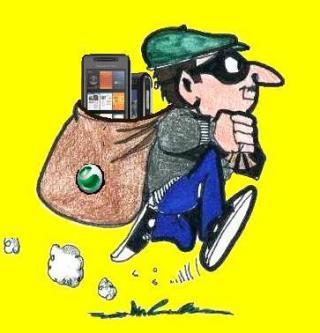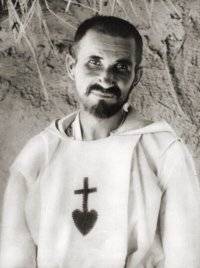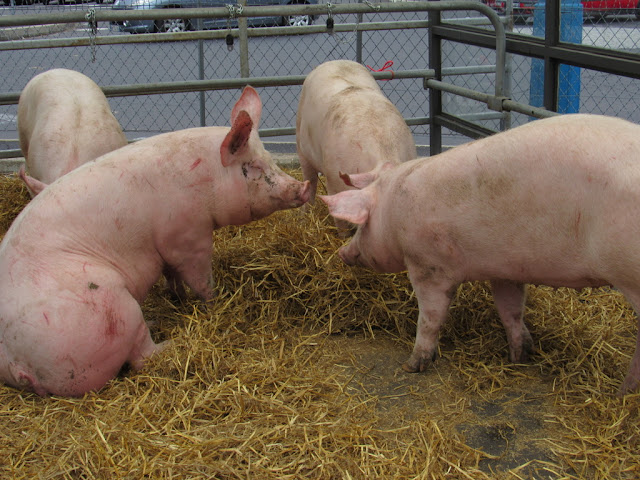
For the French, May 1 is a special day where everyone gets a day off. Stores, banks, and government offices are all closed. People spend this day of leisure with their families or friends.
Fête du Muguet (the Feast of the Lily of the Valley) all started with King Charles IX of France in 1561. He was given the flower as a lucky charm. He liked it so much that he decided to give it every year to the ladies of the court. Today, the flowers are sold in bouquets on the street, at churches, and in stores around France. People offer the flowers to friends or family members for good luck.
Of course, for the Catholic Church, May Day is St. Joseph the Worker Day. The Notre Dame Cathedral in Le Puy held a Mass in honor of St. Joseph this morning.
Happy St. Joseph the Worker Day, especially to the Sisters of St. Joseph!!
Eluiza and I celebrated the day by going to Mass at the Cathedral, making homemade pizza, and taking a day off.
May Day is also Fête du Travail (Labor Day). Trade unions and other workers' organizations use this day for marches in the streets in favor of workers' rights. Called "International Workers Day," the tradition began in 1889 after following the lead of a Chicago workers' strike in 1886 when 35,000 workers walked off their jobs to demonstrate for the 8-hour work day. In 1941, French workers finally won the 8-hour work day, which included getting a paid day off.
This year is especially important one for transportation workers. They are in the midst of a national strike (la gréve) that began in April and is scheduled to continue until June. Fortunately, it takes place only 2-3 days a week, but it requires a lot of maneuvering for travelers.
If you are traveling in France this spring/summer, here is a schedule of rail and air strike days:
Thursday, May 3 - Rail and Air France strike (Tuesday, May 1, is the Fête du Travail public holiday. Public transport will be very limited)
Friday, May 4 - Rail and Air France strike
Monday, May 7 - Air France strike
Tuesday, May 8 - Rail and Air France strike (also a public holiday)
Wednesday, May 9 - Rail strike (Thursday, May 10, is a public holiday)
No air strikes are yet scheduled beyond May 8, but could be called if negotiations fail. Meanwhile, further rail strikes are planned on the following days:
May 13-14
May 18-19 (May 21 is the Pentecôte public holiday)
May 23-24
May 28-29
June 2-3
June 7-8
June 12-13
June 17-18
June 22-23
June 27-28
A list of trains running will be displayed in each station. Any mainline ticket for a cancelled train will be valid on all trains running on that day along the same route. Customers who prefer to cancel their trip has the right to a full refund at the ticket office, regardless of purchase price.

The Independent, an online UK site explains why the French railway workers are on strike in its April 13, 2018, edition.
"The country's railway workers are engaged in industrial action over proposed reforms to the SNCF, the national railway, which will be opened up to competition in 2020 in line with EU requirements.
SNCF employees currently receive automatic annual pay rises, receive 28 days of paid annual leave, are allowed to retire at 50 and are entitled to free tickets for family members.
These perks will be lost under the contractual reforms proposed, which will mean an end to jobs-for-life for new hires.
The SNCF is presently £40 bn in debt and operating at a loss of £5,000 a minute.
France's rail lines are looking at 36 days of strikes in total, two days out of every five from the period beginning on 3 April and scheduled to run until 28 June.
All four of France's main rail unions are involved. In total, 77 per cent of drivers and 34 per cent of staff are downing tools.
Air France pilots, cabin crew and ground staff are also on strike - demanding a 6 per cent pay rise given that their wages have been frozen since 2011. The company is currently only offering a one per cent increase with added benefits and have been duly snubbed."



 There were many events at the Renaissance Festival that took place throughout the five days, and they were well-attended. There were jousting matches, wrestling matches, demonstrations of Renaissance tools, plays, music presentations, puppet shows, and of course, the archery contests that determined who would be crowned King of the Birds. Below are the horses that participated in the jousting matches.
There were many events at the Renaissance Festival that took place throughout the five days, and they were well-attended. There were jousting matches, wrestling matches, demonstrations of Renaissance tools, plays, music presentations, puppet shows, and of course, the archery contests that determined who would be crowned King of the Birds. Below are the horses that participated in the jousting matches.


























































